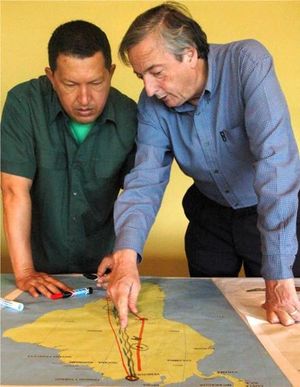Gran Gasoducto del Sur Gas Pipeline
| This article is part of the Global Fossil Infrastructure Tracker, a project of Global Energy Monitor and the Center for Media and Democracy. |
| Sub-articles: |
Gran Gasoducto del Sur Gas Pipeline was a proposed natural gas pipeline.[1] There have been no development updates since its announcement in 2006, and is presumed to be cancelled.
Contents
Location
The proposed pipeline would have run from Puerto Ordaz, Venezuela, through Rondônia, Amazonas and Amapá states in Brazil to Marabá, from Marabá southward to São Paulo State, then to the border between Rio Grande do Sul State and Uruguay, then across Uruguay to Argentina.[2]
Project Details
- Operator: Petrobras
- Parent Company: Petrobas
- Current capacity:
- Proposed capacity: 45.75 billion cubic meters per year
- Length: 5,000 - 9,000 miles / 8,000 - 15,000 km
- Status: Cancelled
- Start Year:
Background
On 9 December 2005, during an annual meeting of Mercosur in Montevideo, the presidents of Venezuela, Argentina, and Brazil signed an accord for the construction of the pipeline.[3] In June 2007 Petrobras president Jose Sergio Gabrielli said that the pipeline would not become operational for 20 to 30 years. In July 2007 Venezuelan President Hugo Chávez said that interest in building the pipeline had cooled.[4]
There have been no development updates since its announcement in 2006.
Route
The exact route of the pipeline was never defined. It was only disclosed that the first 2,950 km (1,930 mi) section was to run from Puerto Ordaz, Venezuela, through Rondônia, Amazonas and Amapá states in Brazil to Marabá, Pará state Brazil. In Manaus, Amazonas State, the pipeline was to be connected to the Urucu–Manaus pipeline and the Urucu-Porto Velho pipeline. From Marabá, a 1,387 km (862 mi) branch line to Fortaleza, Ceará State was foreseen. In Fortaleza the pipeline can be connected to the existing system that extends along the coast to Bahia, Salvador state to be connected with the GASENE pipeline.[1]
The second 1,977 km (1,228 mi) section from Marabá was to continue southward to São Paulo State. From there, the pipeline was to be routed by the 1,875 km (1,165 mi) section to the border between Rio Grande do Sul State and Uruguay and then cross Uruguay to Argentina.[1]
Technical features
The Puerto Ordaz-Marabá section was planned to have a 1700 mm (66 in) diameter and to have 13 compressor stations of 25,000 hp each. The diameter of the Marabá-Fortaleza branch as planned would gradually decrease from 910 mm (36 in) to 810 mm (32 in) and the branch project involved the installation of five 15,000 hp compression stations. The gas amount received in Fortaleza was planned to be 12.75 billion cubic meter (bcm) of natural gas per annum. The Marabá-São Paulo section was to be 1370 mm (54 in) in diameter and to include eight 20,000 hp compression stations. The gas delivered to São Paulo was planned to be 15 bcm per annum. The Brazil-Argentina section with capacity of 18 bcm per annum was to include eight 15,000 hp compressor stations.[1]
Environmental Impact

As shown in the photo to the right, in which former Venezualan President Hugo Chávez and former Argentine President Néstor Kirchner stand above a map with a straight line drawn through the Venezuelan and Brazilian rainforest and the Bolivian, Paraguayan and Argentinean plains, the pipeline would have gone through some of the most protected areas of the world. According to a April 2016 article in Arch Daily, "leaders were apparently indifferent to the environmental and indigenous concerns that would be raised by the implementation of such a project. The inherently modernist nature of such a gesture foregrounds what has been a key political dispute within the left in Latin America: on the one hand, a common political project of national and regional sovereignty based on resource nationalization and, on the other, massive social movements of landless peasants, indigenous populations and environmental activists, fighting back against the expansion of these very extractive economies."[3]
Financing
The project was to be financed by Petróleos de Venezuela S.A., CAF - Development Bank of Latin America, and Caixa Econômica Federal with possible participation of other public institutions and private investors.[1]
Articles and resources
References
- ↑ 1.0 1.1 1.2 1.3 1.4 1.5 Gran Gasoducto del Sur, Wikipedia, accessed February 2018
- ↑ Accord signed for Venezuela-Argentina gas line, Oil & Gas Journal, Jan. 4, 2006
- ↑ 3.0 3.1 The Project of a Collective Line, Arch Daily, Apr. 6, 2016
- ↑ Chávez admite derrota en Gran Gasoducto del Sur (Spanish). South America Energy Markets (2007-08-03). Retrieved on 2007-11-03.
Related SourceWatch articles
External resources
External articles
Wikipedia also has an article on Gran Gasoducto del Sur Gas Pipeline (Gran Gasoducto del Sur). This article may use content from the Wikipedia article under the terms of the Creative Commons Attribution-ShareAlike 3.0 Unported License].